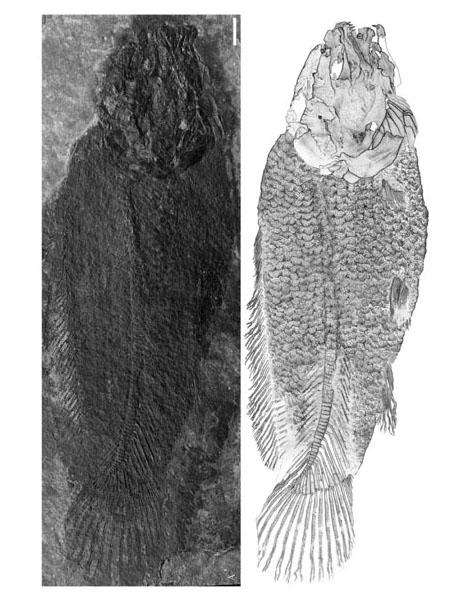Dr. Meemann Chang, Institute of Vertebrate Paleontology & Paleoanthropology, Chinese Academy of Sciences, and her collaborators, described a new amiine fossil fish, Cyclurus orientalis, from the early to middle Eocene Xiawanpu Formation of Xiawanpu, Xiangxiang city, Hunan province, China, as reported in the 2nd issue of Vertebrata PalAsiatica.

Fig.1: Cyclurus orientalis sp. nov.,holotype, photograph (Left) and line-drawing (right) of IVPP V 16285 in left lateral view (Picture/Dr. Meemann Chang)
The specimen is unquestionably an amiine because of the diplospondylous vertebrae of both the normal and alternating types in its preural caudal region, the one-to-one fusion between the ural centra, except the first one, and the hypurals, the absence of the urodermals in the caudal skeleton, and the long dorsal fin. It is referred to Cyclurus because its first coronoid carries teeth with rounded tops. It is different from other species of Cyclurus in having fewer dorsal fin rays, deeper and shorter body, and fewer vertebrae and centra.
"During the Eocene when the transpacific distribution pattern reached its maximum, amiines were not uniquely shared by both sides of the Pacific and thus cannot be taken as an indicator of the transpacific distribution, said Dr. Meemann Chang, Their wider, northern hemisphere distribution, along with the similar distribution of some other fish groups such as Esocidae and Osteoglossidae, may call for an alternative explanation by other special geological backgrounds.
The research was supported by NSFC (grant no.40432003).
Related News
Photos
More>>trade
market
- Chinese Dinosaur Fossils Make North America Debut in Cincinnati
- Human Remains from China Indicate Modern Human Emerged Much Earlier Than
- CAS to Strengthen International Cooperation in 12th Five-year Plan Period
- NATURE: China Pushes for the Proteome
- In Ground-Based Astronomy s Final Frontier, China Aims for New Heights





